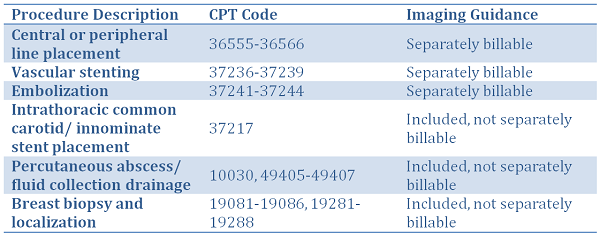 In this blog article that continues our series on how to optimize radiology documentation for maximum reimbursement potential, we address the two most important questions specific to imaging guidance in interventional radiology. Imaging guidance is more and more frequently bundled with the primary interventional procedure, especially with the new CPT[i] codes proposed for 2016. It is, however, still separately billable in certain cases. Regardless of whether it is bundled or not, the radiologist’s documentation for the procedure requires certain elements that thoroughly describe the guidance methods and results. Here are the answers to the two most important questions for your radiology practice to consider.
In this blog article that continues our series on how to optimize radiology documentation for maximum reimbursement potential, we address the two most important questions specific to imaging guidance in interventional radiology. Imaging guidance is more and more frequently bundled with the primary interventional procedure, especially with the new CPT[i] codes proposed for 2016. It is, however, still separately billable in certain cases. Regardless of whether it is bundled or not, the radiologist’s documentation for the procedure requires certain elements that thoroughly describe the guidance methods and results. Here are the answers to the two most important questions for your radiology practice to consider.
What should the documentation include?
These are the elements that must be clearly stated in the procedural report:
- Modality of imaging guidance used
- Local anesthetic agent, concentration and amount infiltrated
- Site of vein entry, vessel patency, and approach to the vessel
- Type, gauge and length of the catheter used
- Number of passes/attempts and any complications
- Confirmation of successful catheter placement
- The final catheter tip position
- Whether a subcutaneous pump or port is in place or not
- Tunneling status
Many of these would normally be included in a comprehensive operative report, and if so it is not necessary to repeat anything specifically for coding the imaging guidance. When both ultrasound and fluoroscopy are used during the same procedure, both must be described in the report. If a second access is required, it is imperative to clearly document the work that was performed via each point of access. Central venous line procedures need particular documentation that states the planned use of the line, the final site of the placement, and the reason the procedure is being performed, as follows:
- Initial insertion of a catheter or device
- Repair of a device
- Partial replacement of only the catheter
- Complete replacement of a device
- Removal of a device
Images obtained during the venous access must be retained, consistent with clinical needs and local health care facility requirements, and the report must contain documentation of such image retention. When fluoroscopy is used, the amount of exposure time must also be included in the description.
Bundled or Billable?
The same documentation requirements apply whether the imaging guidance is included (bundled) within the primary procedure or separately billable. The following table identifies the current billing status for the procedures listed:

The additional reimbursement for each incidence of separately billing ultrasound or fluoroscopic imaging guidance may seem small, but for commonly performed services the aggregate result can amount to a significant improvement in revenue for the related procedures. The following table uses 2015 Medicare rates as an example:

Conclusion
Although imaging guidance is increasingly becoming bundled into the primary procedure, it is still important for radiologists to include a full and detailed description of the venous access procedure as a part of their report. Inaccurate documentation can put the practice at risk for refunds and financial penalties if uncovered by Medicare’s Recovery Audit Contractors (RAC) or other payers’ audits. Using the language contained in the CPT code descriptions will make it easier for auditors to match the documentation with the code assigned and help prevent denials. Regular feedback provided to interventional radiologists about their reporting omissions is an important aspect of training them to provide complete and adequate documentation that will ensure the practice of proper reimbursement.
[i] Current Procedural Terminology (CPT®) is a copyrighted code set developed and maintained by the American Medical Association.





